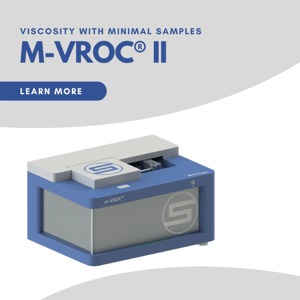
Thank You - Rheology Tools - Determining Intrinsic Viscosity
Application Note
Rheology Tools - Determining Intrinsic Viscosity
Key Words: Intrinsic Viscosity, Formulation Development, Data Analysis, Characterization, Protocol, Huggins Coefficient, Stability, Protein-Protein Interactions
Goal: Here we create an easy-to-follow protocol for intrinsic viscosity analysis performed on a Bovine gamma globulin (BγG) solution prepared with Acetate buffer. This protocol first steps through the derivation of intrinsic viscosity. Then the process to calculate the intrinsic viscosity and Huggins coefficient is presented using both conventional data analysis software and Clariti. The intrinsic viscosity is a useful parameter that can estimate the hydrodynamic size of the (BγG and quantify protein contribution to viscosity. The Huggins coefficient can be used to gauge protein-protein interactions.
Introduction
The intrinsic viscosity analysis can be used to examine the molecular structure and interactions of molecules in suspension. The intrinsic viscosity is a useful parameter for proteins, polymers, and other colloidal suspensions. Intrinsic viscosity measures a solute’s contribution to viscosity at infinite dilution and can be used to calculate molecular size, molecular weight, and molecular stability.
The intrinsic viscosity protocol involves measurement of a concentration series in the dilute regime. The analysis is simplified in the dilute limit since viscosity can be expressed as a series expansion in concentration. The coefficients can then be used to quantify the individual protein contribution and the pair or protein-protein interactions (PPI). The relevant equations and meaning of the extracted parameters are presented here.
In this application note, we will step through a simple procedure to determine the intrinsic viscosity of Bovine gamma globulin in acetate buffer solutions. We begin with the derivation of intrinsic viscosity and defining the parameters needed to calculate it from your viscosity measurements. We then show how to calculate the intrinsic viscosity from dynamic viscosity data using Microsoft Excel and RheoSense’s own data analysis software Clariti.
Derivation
Intrinsic viscosity is the measure of a solute’s contribution to the viscosity at infinite dilution. This parameter must be calculated. The parameters characterizing the individual proteins and their interactions are defined by the Huggins equation, which is a power series expansion of the relative viscosity in terms of concentration applicable in the dilute regime (Macosko, 1994).

The coefficient of the first order term is the intrinsic viscosity, [η], and quantifies the enhancement due to the presence of the individual proteins. The second order coefficient, kH[η]2, includes the Huggins constant, kH, which quantifies the interaction between neighboring protein molecules. In this equation η is the viscosity of the solution (solute and solvent) and μ is the viscosity of only the solvent. Rearranging equation (1) into following equation (2) facilitates analysis requiring only a linear fit to your data.

ηsp is the specific viscosity and c is concentration. To perform intrinsic viscosity analysis, you will need to calculate the specific viscosity of your formulations at multiple concentrations in the dilute limit and perform a linear regression on the data. The next section of this application note will step you through this process on model protein data.
Protocol
- First you need to perform a concentration series experiment on your protein or polymeric solution. For BγG a protein with a molecular weight of approximately 150,000 Daltons, the following five concentrations were analyzed: 0,10, 20, 30, 40, 50 mg/mL. Note: the solutions were created by making a stock 50 mg/mL solution and then diluting that solution to create the 10, 20, 30, and 40 mg/mL solutions. Caution: Be sure that you know the exact concentrations of each solution (Table 1).

Table 1. Concentration Data. These data were used to calculate the exact concentrations of the solutions measured. - With your viscosity data for the five different protein formulations and the formulation buffer in hand, you can now calculate the relative viscosity of each of the protein formulations. Remember relative viscosity is ηrel=η/μ where η is the dynamic viscosity of the protein solution and μ is the viscosity of the solvent alone. In the provided Excel sheet, the solvent is sample 1 with the name Acetate NaCl PS80 Buffer or Acetate NaCl PS80 Arg-HCl Buffer.
- Next determine the specific viscosity (ηsp) by subtracting 1 from the relative viscosity.
- Now divide the specific viscosity of each protein formulation by the formulation’s exact concentration. The viscosity, relative viscosity, specific viscosity, concentration, and ηsp/c data are summarized in Table 2.

Table 2. Summary all viscosity data need to determine .
- Next plot ηsp/C versus concentration in a graphical plotting software such as Microsoft Excel and perform a linear regression on the data (Figure 1).

Figure 1. Intrinsic Viscosity linear regression. A linear fit to the ηsp/C versus concentration data. The intercept of this regression is the intrinsic viscosity, [η] , which has units of mL/mg. The slope in this equation is the Huggins coefficient times [η]2. So the intrinsic viscosity is 0.0064 mL/mg or 6.4 mL/g and the Huggins coefficient is 1.953. - If you have our analysis software Clariti, determining intrinsic viscosity is even easier. On the analysis tab select “Enter Parameters."
- Then enter the concentrations for the buffer and each protein solution in your study. Note: Be sure to put the EXACT concentration. If the concentration is not exact the R2 value of the linear regression will be poor.
- Select all the data you wish to include in the intrinsic viscosity analysis and select add series. Next, in the Series Configuration window under the Analysis column, select “IV” (Figure 2).

Figure 2. Intrinsic Viscosity analysis in Clariti. Clariti can calculate intrinsic viscosity quickly if your data set includes the solvent (buffer) used for the protein formulations. Clariti outputs both the Huggins and Kraemer coefficients and intrinsic viscosity values.
Concluding Remarks
Analyzing data is vital for decision making throughout the research and development process. Here we have shown how to perform intrinsic viscosity analysis on protein formulations. This process can be applied to polymeric solutions and other colloidal suspension. We have also provided data that you can use to practice performing intrinsic viscosity analysis yourself at your convenience in addition to the charts and analysis of the data described in this protocol.
Reference
- Macosko, C.W. 1994 Rheology: Principles, Measurements and Applications. Wiley-VCH
If this note is helpful, please let us know! If you have questions or need more information about this product or other applications, please contact us:
Main Office — 1 925 866 3801
Sales – Sales@RheoSense.com
Information — info@RheoSense.com
.png?width=200&height=58&name=RheoSense%20Logo%20(REGISTERED).png)








